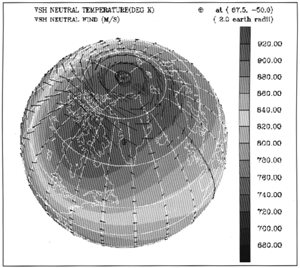Aeronomy is the science of the Earth’s upper atmosphere, including both its physics and its chemistry, covering primarily the regions of the stratosphere, mesosphere, thermosphere, and ionosphere. Researchers at SPRL have played a major role in this science since the late 1940s.
SPRL continues to conduct a broad research effort in both experimental and theoretical aspects of aeronomy. Aeronomical studies have been conducted with SPRL instruments that have been deployed on satellites, sounding rockets, and balloons, as well as at remote ground stations. Theoretical work includes the development and use of large-scale numerical models of the upper atmosphere as well as smaller-scale chemical/dynamical models of atmospheric emissions.
SPRL researchers have written more than 200 papers on results from the two highly successful explorer programs: Atmosphere Explorer (AE) and Dynamics Explorer (DE). The Laboratory built several instruments and instrument components for these two missions (5 spacecraft in total), which have added immeasurably to our understanding of the photochemistry and dynamics of the upper atmosphere, including the ionosphere. Several Laboratory faculty members were selected for participation in the NASA Thermosphere-Ionosphere-Mesosphere Energetics and Dynamics (TIMED) mission. TIMED is a satellite that, since 2001, has conducted the first intensive investigation of the atmospheric region between ~60 and 180 km altitude. SPRL designed and built a Fabry-Perot interferometer to conduct investigations of the winds, temperatures and neutral densities in this region. In addition, SPRL has been heavily involved in the science analysis for this mission.
SPRL also supports four remote field stations that perform routine automatic observations of thermospheric and mesospheric dynamics. Two of these stations, both in Greenland, have just completed their tenth year of sequential measurements making unique studies of solar cycle effects on high-latitude dynamics. These remote field sites house high spectral resolution optical instrumentation that scans the atmosphere in an automated sequence, obtaining information from the upper atmospheric atomic and molecular emissions. A vigorous sounding rocket aeronomy research program is well into its third decade. Rocket-borne measurements of trace constituent abundances and emission rates have provided information that is key to our understanding of atomic oxygen and hydrogen chemistry in the middle atmosphere, as well as the atmospheric dynamics and energetics in this region.
Theoretical studies in aeronomy at SPRL involve analytical efforts and numerical code development. The Laboratory has a 30 year history of theoretical investigations of the ionosphere. In recent years, theoretical tools have been developed to study the neutral thermosphere as well. A strong collaboration with scientists at the National Center for Atmospheric Research (NCAR) in Boulder, CO, has allowed SPRL faculty to develop useful diagnostic tools for use with the NCAR family of general circulation models. Diagnostic processors developed at SPRL have improved our knowledge and understanding of the forcing processes responsible for upper atmospheric perturbations. Recently, SPRL researchers have developed an accurate and fast semi-empirical model for global upper atmospheric densities and winds. They have also developed a new “nested grid” model of the coupled ionosphere-thermosphere (derived from the NCAR codes) that is capable of very high spatial and temporal resolution.

